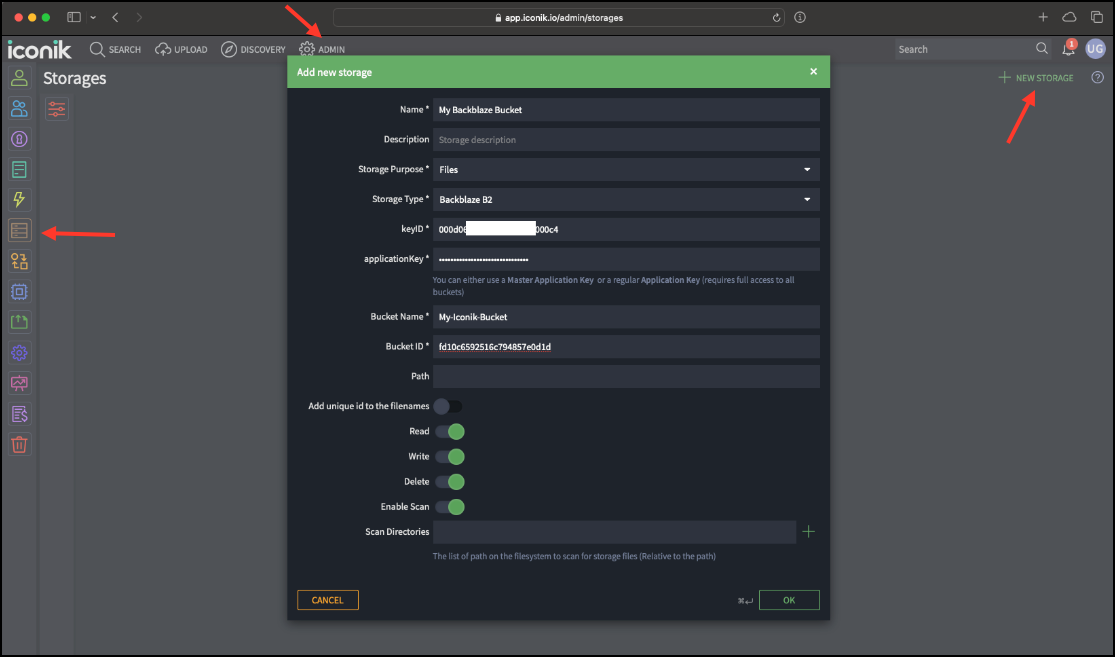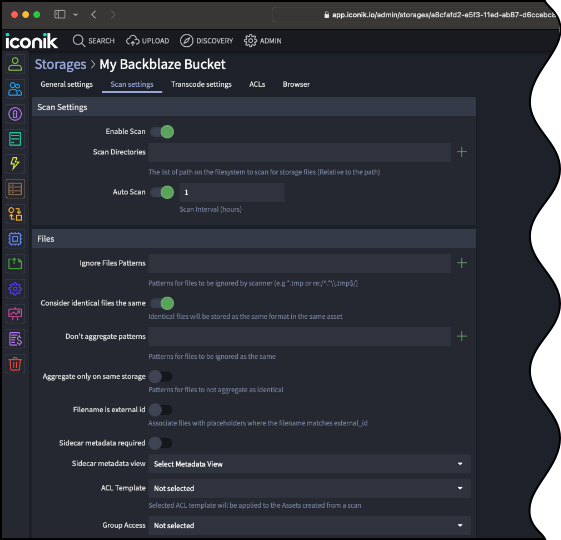- Print
- DarkLight
Iconik Integration with Backblaze B2
- Print
- DarkLight
iconik is a powerful cloud-based media asset management (MAM) solution that lets you make your content that is stored in Backblaze B2 Cloud Storage fully intractable through a web browser. This guide provides the steps to add a Backblaze B2 bucket that contains your media into iconik. Once linked, iconik scans the media resources that you have in your bucket, transcodes them into web proxies, and displays them in a searchable catalog.
This article provides the steps to connect iconik to Backblaze B2, but you can also watch the following video tutorial: Getting Started with iconik and Backblaze B2.
Enable Backblaze B2
Before you begin: You must have a Backblaze B2 Cloud Storage account. If you already have a Backblaze account and the left navigation menu contains a B2 Cloud Storage section, your account is already enabled for Backblaze B2.
- Sign in to the Backblaze web console.
- In the user menu in the upper-right corner of the page, select My Settings.
- Under Enabled Products, select the checkbox to enable B2 Cloud Storage.
- Review the Terms and Conditions, and click OK to accept them.
Create a Bucket
- Sign in to the Backblaze web console.
- In the left navigation menu under B2 Cloud Storage, click Buckets.
- Click Create a Bucket.
- Enter a name for your bucket. Bucket names must be at least six characters and globally unique.
A message is displayed if your bucket name is already in use. - Select a privacy setting: Private or Public.NoteYou can change a bucket's privacy settings at any time.
Files that are in a private bucket require authentication to perform an action, for example, downloading.
Public buckets do not require authentication so you can easily access files. If this is your first time creating a public bucket, complete the following tasks to ensure that you have the correct permissions to create a public bucket:
1. Verify your email address.
2. Have a payment history on file, or use the credit card form to pay a small fee that is credited to your account balance. - If applicable, enable a Backblaze B2 server-side encryption key.
- Enable Object Lock to restrict a file from being modified or deleted for a specified period of time.
- Click Create a Bucket, and copy the value that is in the Endpoint field; you may need this value later.
- Click Lifecycle Settings to control how long to keep the files in your new bucket.
Create an App key
- Sign in to the Backblaze web console.
- In the left navigation menu under B2 Cloud Storage, click Application Keys.
- Click Add a New Application Key, and enter an app key name. Please note: You cannot search an app key by this name; therefore, app key names are not required to be globally unique. Key names are limited to 100 characters and can contain letters, numbers, and "-", but not I18N characters, such as é, à, and ü.
- Select All in the Allow Access to Bucket(s) menu.
- Select Read and Write as the Type of Access.
- Optionally, select the Allow List All Bucket Names checkbox (required for the B2 Native API b2_list_buckets and the S3-Compatible API S3 List Buckets operations).
- Optionally, enter a file name prefix to restrict application key access only to files with that prefix. This limits application key access to files with the specified prefix for all buckets or just the selected bucket.
- Optionally, enter a positive integer to limit the time, in seconds, before the application key expires. The value must be less than 1000 days (in seconds).
- Click Create New Key, and note the resulting keyID and applicationKey values.
Add a Storage Type

- Sign in to iconik, click ADMIN in the upper navigation menu, and click Storages in the left menu.
- Click NEW STORAGE, and add storage details.
- Enter a name for your storage.
- Enter a description.
- Select a storage purpose depending on your particular needs. If you use the bucket for active media data that you will import into iconik, select Files.
- Select Backblaze B2 as the storage type.
- Enter your Backblaze B2 keyID and applicationKey.
- Enter your bucket name and bucket ID.
- Enter the path. If the directory that contains media is nested, indicate that using in this Path setting.
- Enable permissions for your integration. If you need iconik to generate proxies, select Enable Scan.
- Optionally, set the scan directories so that iconik knows that the specific directory contains files that should be transcoded.
- Click OK.
Green check marks indicate that iconik was able to communicate with the Backblaze B2 bucket.
Generate a Web Proxy
You can use the iconik transcoders to generate web proxies by modifying the scan settings to allow iconik to automatically scan and index data. This is convenient if the bucket is actively getting new data that needs to be added to iconik.

- Select the Scan settings tab.
- Turn on the toggle for Enable Scan.
- Turn on the toggle for Auto Scan, and set this value to an interval that works for your integration.
- Select the Transcoders tab to set up and configure transcoders.
- Select the Transcode settings tab, and set the transcoder that you want to use for the bucket scans.
- Select the Search tab to browse and view the media data that is in your Backblaze B2 bucket.
